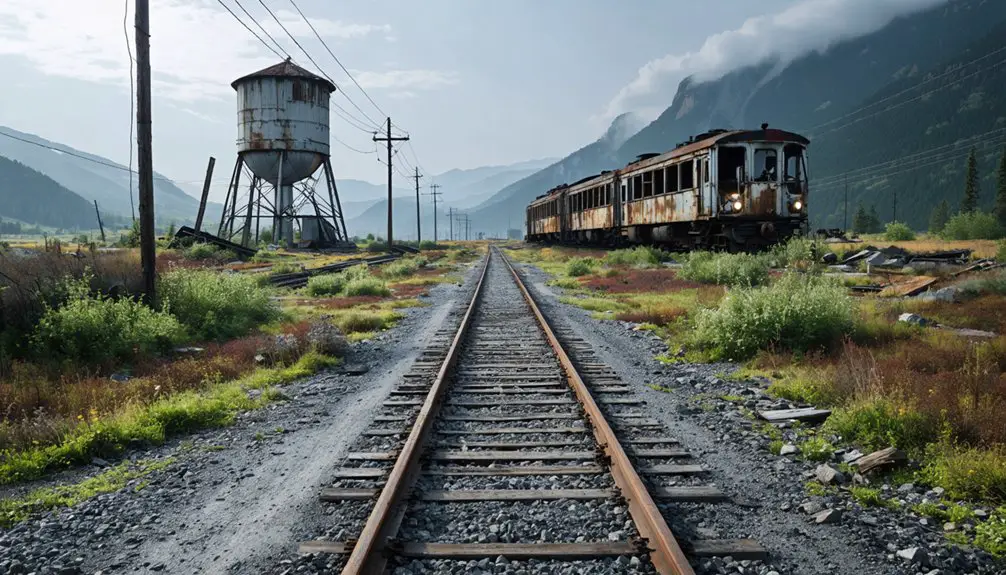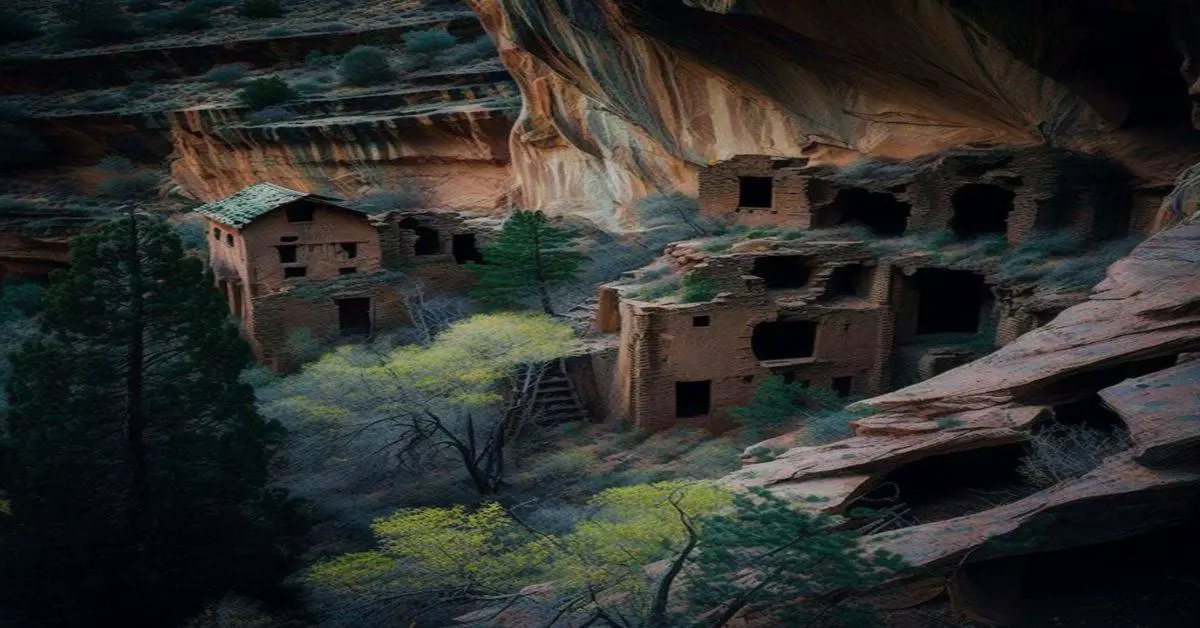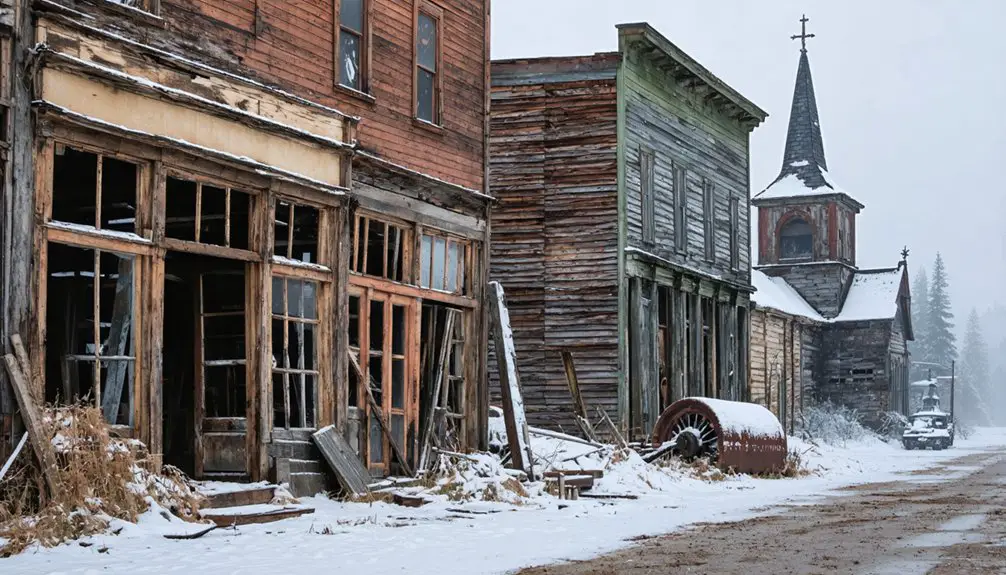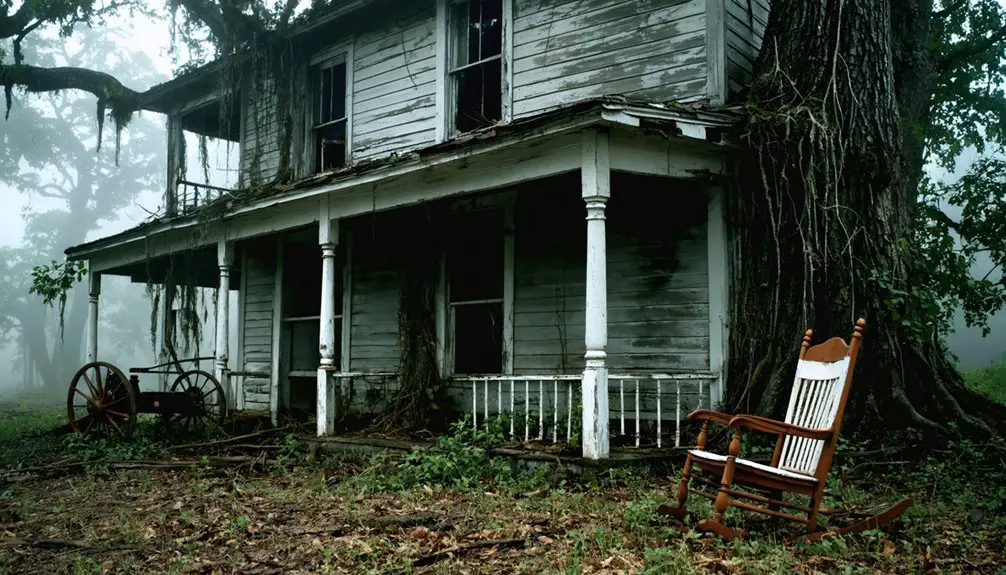You’ll find Goodwill nestled in Mercer County, West Virginia, where Robert and Philip Goodwill established a coal mine in 1886. The town quickly grew into a bustling mining community with company stores, churches, and essential infrastructure supporting the coal operations. Under Solvay Collieries, the town experienced its heyday from 1915 to 1922, but declined after the Great Depression. Today’s ghost town holds fascinating remnants of its industrial past, with each abandoned structure telling a unique story of Appalachian coal heritage.
Key Takeaways
- Goodwill was established in 1886 as a coal mining town by Robert and Philip Goodwill in Mercer County, West Virginia.
- The town flourished during peak mining years from 1915-1922 under Solvay Collieries before declining after Winding Gulf Collieries closed in 1958.
- Residents lived in company-controlled housing, with daily life centered around mining operations and company-owned facilities like stores and schools.
- The Great Depression triggered Goodwill’s transformation into a ghost town, marked by business closures and mass exodus of residents.
- The abandoned town’s remains include deteriorating infrastructure from its mining era, while preservation efforts maintain its historical legacy.
Origins of a Mining Town
When Robert and Philip Goodwill opened their coal mine in 1886, they laid the foundation for what would become a bustling mining town in Mercer County.
You’ll find that these early settlers weren’t alone in their vision, as Justus Collins established another mine just a year later in 1887, setting the stage for rapid expansion.
The town’s industrial blueprint quickly took shape around these mines, with essential infrastructure emerging to support the growing coal mining operations.
As coal mines anchored the town’s core, vital infrastructure grew around them, transforming raw land into an industrial powerhouse.
You can imagine the hum of activity as sawmills sprung up to provide lumber, while coal tipples dotted the landscape, processing the precious black rock.
The town’s layout reflected its purpose, with carefully planned facilities and housing positioned to serve the miners and their families who’d soon call Goodwill home.
The development of two company stores became central gathering places where families would meet daily to shop and socialize.
The community’s spiritual needs were met through the construction of three churches that served the growing population.
The Goodwill Family Legacy
The Goodwill family’s influence extended far beyond the initial mine opening, shaping every aspect of the town that bore their name. When Robert and Phillip Goodwill established their coal mining enterprise in 1886, they didn’t just create a business – they built an entire community.
Their vision encompassed two company stores, multiple power plants, and coal tipples that became the town’s economic backbone. Similar to Thurmond’s record of nearly $5 million in railroad revenue receipts, Goodwill’s mining operations generated substantial income for the region. Like Thurmond’s strict ban on drinking, the Goodwills maintained tight control over social activities in their mining town.
You’ll find the Goodwill family’s commitment to community cohesion reflected in the town’s carefully planned infrastructure. They established two schools for miners’ children, supported three churches for spiritual life, and maintained a union hall that served as a gathering place.
This all-encompassing approach to town development created a self-sustaining ecosystem where residents’ daily lives revolved around both work and community.
Mining Operations and Economic Growth
You’ll find Goodwill’s most productive mining period occurred between 1915 and 1922 under Solvay Collieries’ management, when industrial-scale coal preparation reached its zenith.
The mines utilized standard deep mining techniques of the era, including timber supports, rail cars, and mechanical coal cutters to extract the valuable resource. The site operated continuously until Winding Gulf Collieries closed operations in 1958.
The Louisville Mine’s 1887 establishment introduced modern coal loading systems, setting a precedent for efficient extraction methods that would define Goodwill’s mining operations for decades to come. The operation’s preparation plant in Mercer County played a crucial role in processing the extracted coal.
Peak Production Years
During West Virginia’s golden age of coal production, mining operations reached unprecedented heights with two remarkable peaks: 146 million tons in 1927 and 174 million tons in 1947.
You’ll find that community resilience and labor activism shaped these peak years, as miners fought for better working conditions while powering America’s industrial growth.
- Production skyrocketed from 4.9 million tons in 1887 to 89.4 million tons by 1917
- Post-1936 mechanization transformed mining with conveyor belts and shuttle cars
- Surface mining revolutionized operations through power shovels and draglines
- The workforce grew to 90,000 employees, including foreign-born and African American miners
- Company towns housed workers, though they often lacked basic civic institutions
The mining companies provided essential services through company stores and scrip, which workers used to purchase their daily necessities. The development of the Chesapeake & Ohio Railway in 1873 played a crucial role in connecting the coalfields to national markets.
Mining Equipment and Methods
Picks and shovels marked the humble beginnings of West Virginia’s coal mining operations, with miners relying entirely on manual labor until mechanization gradually transformed the industry. The mines used a drift entry system where horizontal tunnels accessed coal seams directly through hillsides.
You’d have seen a dramatic shift in coal extraction methods starting around 1900, when mechanized undercutting machines first appeared in the mines. By the 1920s, loading machines began replacing manual labor, and the transformation was striking – from just 2% machine-loaded coal in 1935 to 99% by 1955. Trolley-operated locomotives replaced animal-drawn transport for main haulage in the early 1900s.
The mines primarily used room-and-pillar methods, where miners carved out chambers while leaving support pillars of coal.
Later, more advanced mechanized methods like longwall mining and continuous miners revolutionized operations. Electric-powered equipment, from ventilation systems to conveyor belts, replaced earlier systems that relied on mules and steam power.
Daily Life in the Coal Camp
Life in Goodwill’s coal camp revolved around a stark hierarchy of company control, where rows of unpainted houses lined gravel roads and modern amenities like TV antennas stood in contrast to the austere living conditions.
Your daily routines would’ve been dictated by the company’s grip on every aspect of life, from healthcare to shopping. Community gatherings happened in the shadow of economic dependency, with social interactions confined to spaces near the company store and clinic.
- You’d find yourself paying for basic medical care through wage deductions.
- Your housing quality depended on your position in the camp’s social hierarchy.
- You couldn’t shop anywhere except the company store, often falling into debt.
- Your children would attend company-owned schools.
- You’d rely on a single doctor with limited supplies for all medical needs.
Transportation and Infrastructure

Beyond the confines of the coal camp’s controlled environment, Thurmond’s rail system stood as the beating heart of the town’s existence. You’d find a bustling transportation network that handled more freight than Cincinnati, with the C&O Railway’s mainline processing up to 95,000 passengers yearly through 15 daily trains.
The town’s infrastructure development centered on its 1883 freight station and the essential 1889 New River bridge.
While the rail yard expanded impressively by 1910, Thurmond’s remote location in the steep New River Gorge meant limited road access. When diesel engines replaced steam locomotives and coal mining declined, you’d see the town’s significant transportation role diminish.
The narrow, winding roads couldn’t sustain the economy once rail traffic dwindled, leaving Thurmond’s historic infrastructure preserved within today’s national park.
Peak Years and Local Industry
You’ll find Goodwill’s industrial might began with the Goodwill brothers’ 1886 coal mine opening, followed quickly by Justus Collins’ additional mine in 1887.
The town’s rapid expansion included two bustling sawmills that supplied essential lumber for both local construction and mining operations.
These core industries created a transportation boom as rail lines carried coal, lumber, and supplies in and out of the thriving community.
Mining Operations Expand Rapidly
Mining operations in Goodwill expanded dramatically in the late 1880s, starting with the Goodwill brothers‘ initial coal mine in 1886. The rapid mining expansion continued when Justus Collins opened another mine in 1887, followed by the Louisville Coal and Coke Company establishing their operation that same year.
You’ll find that workforce dynamics shifted as multiple mines created significant employment opportunities throughout the region.
- The Louisville operation built a sophisticated preparation plant
- Company stores and offices supported the growing workforce
- Multiple concurrent mining operations increased total coal production
- Mining infrastructure expanded to process and market coal beyond extraction
- The town’s economy thrived as mining companies invested in processing facilities
The concurrent development of these mining operations transformed Goodwill from a small settlement into a bustling coal camp community with robust industrial infrastructure.
Local Sawmills Support Growth
Two bustling sawmills formed the backbone of Goodwill’s early 1900s industrial expansion, operating alongside the town’s coal mining operations.
Their sawmill impact extended beyond timber processing, helping transform Goodwill into a thriving industrial hub complete with power plants, stores, schools, and churches.
You’d have witnessed an impressive operation if you’d visited during these peak years. Steam-powered machinery hummed as logs arrived by rail, ready for processing into lumber.
The sawmills’ output contributed to West Virginia’s billion-board-feet production levels, while their waste wood helped power local steam generation.
These mills weren’t just about lumber – they represented Goodwill’s economic importance, providing jobs and supporting the town’s growth during an era when industrial-scale harvesting was reshaping West Virginia’s timber industry.
Railway Transportation Booms
The railway boom of the 1880s accelerated Goodwill’s industrial growth far beyond its sawmill operations. The transportation legacy of Norfolk & Western Railway and Virginian Railway transformed this small town into a crucial coal shipping hub that would thrive until 1958.
You’ll find evidence of this railway expansion in the dual tunnels near Matoaka and the extensive infrastructure built to support coal transport.
- Coal companies like Winding Gulf Collieries dominated the local economy through rail networks.
- Dedicated rail lines connected mines at Cooper and Arista to major markets.
- Railways enabled efficient movement of materials, workers, and coal exports.
- Company stores and facilities were strategically placed along rail corridors.
- Multiple competing railways invested heavily in the region’s infrastructure.
These rail connections proved indispensable to Goodwill’s rise as a significant player in the Pocahontas Coalfield region.
The Decline Era
While Thurmond once thrived as a bustling railway hub, its decline began sharply during the Great Depression of the 1930s, marked by devastating economic blows and social upheaval.
You’d have witnessed the closure of the National Bank of Thurmond in 1931, followed by widespread business shutdowns and mass exodus of residents seeking work elsewhere.
The catastrophic fire of 1930 destroyed the iconic Dunglen Hotel, dealing a $100,000 blow to the community’s infrastructure and morale.
The devastating Dunglen Hotel fire of 1930 shattered more than just a building – it broke the spirit of Thurmond itself.
Economic hardships intensified as diesel locomotives replaced steam engines, severely reducing coal demand and railway traffic.
The social decline accelerated amid rising crime rates and violence, earning Thurmond the ominous nickname “Dodge City of the East.”
The town’s transformation from commercial center to near-ghost town proved swift and irreversible.
Remnants and Historical Sites
Amid the ruins of this once-vibrant community, Goodwill’s most prominent survivor stands as a symbol to its coal-rich past – the 1904 Goodwill house, complete with its grand third-floor ballroom and distinctive Italian stone masonry.
As one of the region’s most significant cultural landmarks, it represents the architectural features that defined early 20th-century coal town prosperity.
- Original coal company structures dot the landscape, though most have succumbed to decay.
- Nature steadily reclaims the town site, with vegetation overtaking former streets and lots.
- Mining infrastructure remnants hint at the area’s industrial heritage.
- Local cemeteries and memorial sites preserve connections to past residents.
- The transformed topography bears witness to extensive mining activities.
Today, you’ll find the ghost town’s remaining structures serving as silent testimonials to an era when coal fueled both the economy and community life.
Preserving Goodwill’s Memory
Since Goodwill’s shift to ghost town status in 1958, dedicated historians and community members have worked tirelessly to preserve its rich cultural legacy through multiple channels.
You’ll find the town’s history documented through local archives, oral histories, and photographs that capture its coal mining heritage and community life.
Annual reunions strengthen community engagement, as former residents and their descendants gather to share memories and artifacts.
Digital preservation efforts have expanded access to Goodwill’s historical significance through online forums, virtual archives, and documentary features.
Regional museums and heritage centers incorporate Goodwill’s story into broader exhibitions about Appalachian coal communities, while educational programs help younger generations understand the town’s impact on West Virginia’s industrial development.
These combined efforts guarantee that Goodwill’s memory lives on beyond its physical remains.
Frequently Asked Questions
What Natural Disasters or Accidents Occurred in Goodwill’s Mines?
Among 21,000+ mining deaths in West Virginia, you’ll find no specific records of mine collapses or flooding incidents in Goodwill, though the region faced typical coal mining hazards.
Were There Any Notable Conflicts Between Mine Owners and Workers?
While you’d expect labor disputes and mining strikes given the era’s coal industry tensions, there’s no conclusive evidence of major conflicts between Goodwill’s mine owners and workers in historical records.
What Happened to the Residents After the Town Was Abandoned?
Like scattered seeds in the wind, you’ll find former residents’ relocation led them to nearby towns and cities seeking new jobs, while their community legacy lives on through stories.
Did Any Famous People or Events Originate From Goodwill?
You won’t find any nationally famous residents from this coal town. Beyond the founders Robert and Phillip Goodwill and mine owner Justus Collins, the town’s historical significance lies in its coal industry legacy.
What Indigenous Peoples Lived in the Area Before Goodwill’s Establishment?
You’ll find the Shawnee, Delaware, and Cherokee Native tribes were the main indigenous peoples who influenced this region’s cultural heritage, with Iroquoian-speaking groups like the Seneca also maintaining presence.
References
- https://www.bramwellwv.com/goodwillhis1.html
- https://www.youtube.com/watch?v=WEEFtomS7co
- https://www.bramwellwv.com/goodwillhis.html
- https://en.wikipedia.org/wiki/List_of_ghost_towns_in_West_Virginia
- https://www.wikiwand.com/en/articles/Goodwill
- https://wvtourism.com/visit-west-virginias-former-town-of-millionaires-bramwell/
- https://www.ghosttowns.com/states/wv/goodwill.html
- https://www.youtube.com/watch?v=e7rsB4kOmyE
- https://www.youtube.com/watch?v=yBKOIRxeNX0
- https://minskysabandoned.com/2015/08/06/west-virginia-ghost-towns-part-2-thurmond/



